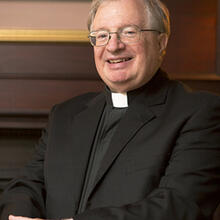Though I grew up within the confines of New York City, at heart I am not a city boy. My boyhood home on the north shore of Staten Island stood on a dead end street. Just a block long, the street was bordered on two sides by woodlands. At the far end of the block was a private park with more woods, streams, a marsh and a pond. There we would scamper after salamanders in the spring and collect unlucky box turtles to carry home as pets. Much of the year we awoke to the crowing of pheasants as they fed in the neighboring yards. We lived, a Jesuit retreat master quipped, in “the garden spot of the cement and asphalt jungle.” It was a life that left me with an affinity for the land and its problems.
At certain times of year the church’s liturgy reminds me of my attachment to the land. In the summer, for example, readings of the parables of the kingdom and stories of Jesus’ ministry out in the open, on the water and hillsides, bring to mind the landscape of the Holy Land, the wildflowers of Galilee, the bird life on the slopes of Mount Zion. The late Benedictine biblical archeologist and geographer Bargil Pixner called the geography of the Holy Land “the Fifth Gospel.” “Whoever has learnt to read and peruse this ‘book’ of biblical landscape,” he wrote, “will experience the message of the four Gospels with a new and greater clarity.”
Pixner’s own feel for the landscape of the Holy Land and his scholarship grew out of his 12 years at Tabgha on the Sea of Galilee, where he acquired a sense of “the distances from one place to another, and for the seasons of drought and of rainfall. Each season,” he wrote, “has its particular wind direction, times of heat and cold. I have learned much about the lake and about fishing and navigations....” Attention to the details of landscape, climate and the habits of fishermen and farmers gave him confidence in the authenticity of the Gospel accounts of Jesus’ life. In two books, With Jesus Through Galilee According to the Fifth Gospel (1992) and With Jesus in Jerusalem: His First and Last Days in Judea (1996), he spelled out his reading of the geography of salvation.
The biblical landscape Pixner loved, however, is fast disappearing. Thousand-year-old olive groves have been bulldozed to deny terrorists cover, and ridge lines have been obscured by settlements intended to dominate the surrounding region. At Shepherd’s Field, a Franciscan shrine near Bethlehem, a decade ago pilgrims could watch as shepherds moved their flocks down the opposite hillside and then east into the Judean desert, but today pilgrims no longer have the opportunity to enjoy that scene, and the Bedouin shepherds themselves have been removed.
First came Har Homa, the Israeli settlement built on a hill where a forest once stood, anchoring the southern end of the security circle around Jerusalem. By 2000, middlemen had purchased much of the adjoining open land for settlement expansion. While it could, until 2000, the Palestinian Authority aped the Israeli “edifice complex,” building homes right up to the edge of the land it then controlled beneath the hill. Subsequently the security barrier, or wall, built to keep Palestinian terrorists from entering Israel, further scarred the terrain. Like the Great Wall of China, it is now an unavoidable feature of the landscape.
Ein Kerem is a Judean hill town associated with the birth of John the Baptist. Situated in a narrow valley between forested ridges, it was famed for its natural beauty and moderate climate. Eventually artists and craftsmen discovered Ein Kerem and made it a hideaway; then development began encroaching. When I was last there, a forest atop the mountain to the north was over-towered by construction cranes, and the plain that spreads out beneath the valley was sprouting more housing.
In the 1990s, the Holy See frequently made preservation of the historic biblical environment one of its hopes for an Israeli-Palestinian peace agreement. Many pilgrims, both Jews and Christians, lament the passing of the biblical landscape. But today conserving the geography of salvation is a moot point. Much of it is buried beneath concrete and steel. Pixner’s “Fifth Gospel” has been sacrificed to the twin gods of fear and security. In the meantime, the woods near my boyhood home were purchased by a conservancy that will protect one, small “garden spot” in “the cement and asphalt jungle.”








